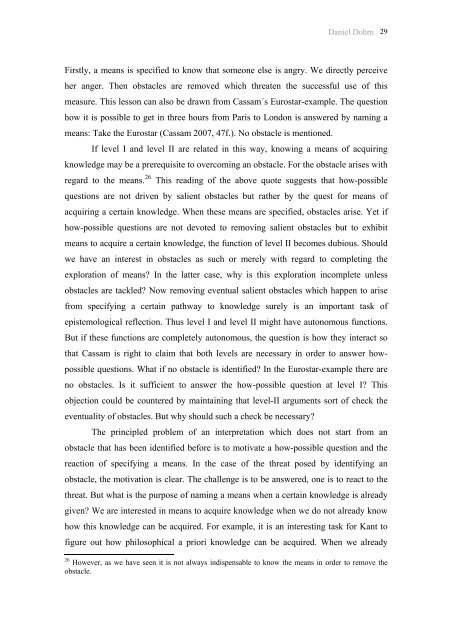Complete Issue in PDF - Abstracta
Complete Issue in PDF - Abstracta
Complete Issue in PDF - Abstracta
Create successful ePaper yourself
Turn your PDF publications into a flip-book with our unique Google optimized e-Paper software.
Daniel Dohrn 29<br />
Firstly, a means is specified to know that someone else is angry. We directly perceive<br />
her anger. Then obstacles are removed which threaten the successful use of this<br />
measure. This lesson can also be drawn from Cassam´s Eurostar-example. The question<br />
how it is possible to get <strong>in</strong> three hours from Paris to London is answered by nam<strong>in</strong>g a<br />
means: Take the Eurostar (Cassam 2007, 47f.). No obstacle is mentioned.<br />
If level I and level II are related <strong>in</strong> this way, know<strong>in</strong>g a means of acquir<strong>in</strong>g<br />
knowledge may be a prerequisite to overcom<strong>in</strong>g an obstacle. For the obstacle arises with<br />
regard to the means. 26 This read<strong>in</strong>g of the above quote suggests that how-possible<br />
questions are not driven by salient obstacles but rather by the quest for means of<br />
acquir<strong>in</strong>g a certa<strong>in</strong> knowledge. When these means are specified, obstacles arise. Yet if<br />
how-possible questions are not devoted to remov<strong>in</strong>g salient obstacles but to exhibit<br />
means to acquire a certa<strong>in</strong> knowledge, the function of level II becomes dubious. Should<br />
we have an <strong>in</strong>terest <strong>in</strong> obstacles as such or merely with regard to complet<strong>in</strong>g the<br />
exploration of means? In the latter case, why is this exploration <strong>in</strong>complete unless<br />
obstacles are tackled? Now remov<strong>in</strong>g eventual salient obstacles which happen to arise<br />
from specify<strong>in</strong>g a certa<strong>in</strong> pathway to knowledge surely is an important task of<br />
epistemological reflection. Thus level I and level II might have autonomous functions.<br />
But if these functions are completely autonomous, the question is how they <strong>in</strong>teract so<br />
that Cassam is right to claim that both levels are necessary <strong>in</strong> order to answer how-<br />
possible questions. What if no obstacle is identified? In the Eurostar-example there are<br />
no obstacles. Is it sufficient to answer the how-possible question at level I? This<br />
objection could be countered by ma<strong>in</strong>ta<strong>in</strong><strong>in</strong>g that level-II arguments sort of check the<br />
eventuality of obstacles. But why should such a check be necessary?<br />
The pr<strong>in</strong>cipled problem of an <strong>in</strong>terpretation which does not start from an<br />
obstacle that has been identified before is to motivate a how-possible question and the<br />
reaction of specify<strong>in</strong>g a means. In the case of the threat posed by identify<strong>in</strong>g an<br />
obstacle, the motivation is clear. The challenge is to be answered, one is to react to the<br />
threat. But what is the purpose of nam<strong>in</strong>g a means when a certa<strong>in</strong> knowledge is already<br />
given? We are <strong>in</strong>terested <strong>in</strong> means to acquire knowledge when we do not already know<br />
how this knowledge can be acquired. For example, it is an <strong>in</strong>terest<strong>in</strong>g task for Kant to<br />
figure out how philosophical a priori knowledge can be acquired. When we already<br />
26 However, as we have seen it is not always <strong>in</strong>dispensable to know the means <strong>in</strong> order to remove the<br />
obstacle.




